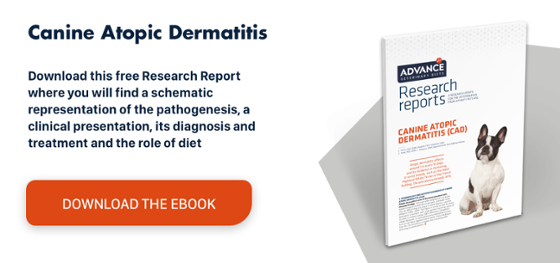What causes feline miliary dermatitis?
As mentioned above, the main cause of feline miliary dermatitis is flea bite hypersensitivity. Some cats become extremely sensitive to fleas and a single bite can be enough to cause a quite severe skin reaction. This skin condition is more likely to develop in cats that live in warm climates.
It may be caused by other factors or a combination of several:
- Other allergies (atopic dermatitis, inhalants, food intolerances, insect intolerances)
- Infection (dermatophytosis or superficial pyoderma)
- Parasites (notoedric mange, demodicosis, cheyletiellosis, pediculosis, ear mites)
- Immune-mediated diseases (eosinophilic granuloma, lupus erythematosus or pemphigus foliaceus)
- Reaction to medications
This article outlines some of the underlying causes of feline miliary dermatitis:
Feline dermatitis or hypersensitivity
The age of onset varies but is generally between 6 months and 3 years, with a higher incidence in purebred cats and may or may not be seasonal. As in dogs, cats with atopic dermatitis can have various clinical presentations, such as miliary dermatitis, symmetrical alopecia, eosinophilic granuloma complex and abrasions on the head and neck, all compatible with a diagnosis of atopic dermatitis and which should be differentiated from other diseases with similar clinical signs.
Food intolerances
These are the third-most prevalent allergy in cats, surpassed in frequency only by allergies to flea bites and inhaled substances. The most characteristic skin lesions are miliary dermatitis, self-induced alopecia, eosinophilic granuloma complex and facial abrasions. Besides the skin disorders, gastrointestinal signs, such as vomiting and diarrhoea, can also be observed.
Dermatophytosis
Dermatophytosis is a fungal infection that causes superficial skin disease, with 90% of cases due to Microsporum canis. Predisposing factors for dermatophytosis are skin trauma (ectoparasites and wounds), immunosuppression, nutritional deficiencies and a warm environment. The most typical lesions are regular, circular patches of alopecia with broken hair and flaking skin, sometimes with an erythematous margin around central healing (ringworm). Other signs in affected cats include seborrhoea, scabs, miliary dermatitis, warm nodules and paronychia.
Notoedric mange
This is a parasitic disease caused by a mite in the Sarcoptidae family (Notoedres cati). The characteristic clinical signs include intense pruritus, erythematous crusted papules, pyoderma, alopecia and seborrhoea. It starts in the medial area of the pinna, face and neck, and can spread to other areas of the cat’s body. Without proper treatment it can lead to hyperkeratosis or hyperpigmentation in the affected areas.
Cheyletiellosis
An extremely contagious ectoparasitosis. The three mite species primarily responsible for Cheyletiellosis are Cheyletiella blakei (cats), Cheyletiella parasitovorax (rabbits), Cheyletiella yasguri (dogs). As they are large mites, they can be detected on the animal’s coat by their scale-like appearance. Lesions appear mainly on the animal’s head and trunk, producing pruritus, alopecia, miliary dermatitis, erythema, scaling and crusting.
Pemphigus foliaceus
Pemphigus foliaceus is an autoimmune dermatological disease. It is usually idiopathic but sometimes induced by medications or as a sequela to inflammatory skin disease. In general, the primary lesions of pemphigus foliaceus are superficial pustules that are partially or totally covered by crusts, which turn into crusting papular erosions, as well as flaking and alopecia. It commonly starts on the head and ear canal. Cats may also suffer from noticeable oozing from nail tissue (caseous paronychia) which can develop into onychodystrophy.

